- Home
- Fishing Rigs
Saltwater Fishing Rigs for
Shore Fishing and Boat Fishing
Fundamentally, saltwater fishing rigs must be designed and constructed such that they present your bait, or lure, in a manner which looks natural to a fish.
And they won't do that if they tumble on their flight through the air, or tangle on the drop to the seabed.
One way to ensure that they your bait rigs do as intended is to
follow proven designs when you make them up or alternatively, buy them
as professionally made-up rigs from your tackle supplier.
Many anglers choose this latter approach, saying they'd rather spend their time fishing than making up rigs.
On this page...
And that's fine of course, but if you want to cut down on your spending the smart thing to do is to buy a few rig making accessories together with a small selection of ready-made rigs just to use as patterns - and then copy them shamelessly!
Some ready-made rigs come with fully dimensioned sketches in the packaging, which is very useful.
Of course once you've made each of the popular rigs a few times it will become second nature, and the rig making instruction will be no longer required.
But in the meantime...
Bottom Rigs for Boat and Shore Fishing
Bait Rigs are generally designed around one of two basic forms:~
- The Paternoster Rig, or
- The Running Ledger Rig or
- A combination of the two
Most of the popular bait rigs - flapper rigs, pulley rigs, wishbone rigs, clip-down rigs etc - are all derivatives of these basic rig patterns and are designed to place the bait on the seabed, where the fish would expect to find it.
Boat Fishing Rigs
All the popular paternoster and ledger rig variations apply here, but most bottom fishing rigs designed for boat fishing feature longer hook traces than would be practical for surf fishing rigs.
This is because these boat rigs can be lowered to the seabed without tangling, where the long traces will flutter around enticingly in the tide.
One exception is the conger rig, which should always present the bait fixed firmly to the seabed. Conger eels seem keener to hunt down your bait by its scent alone, and show little enthusiasm for chasing it around.
Read more about Boat Fishing Rigs...
Surf Fishing Rigs
The essence of a good surf fishing rig is not only that it must present your bait enticingly on the seabed, but also that it must:~
- cast like a bullet, and
- protect your bait during flight and on 'splash-down'.
... which is why bait clips and impact shields were developed, and how clip-down rigs have so benefited surfcasters on both sides of the Atlantic.
Some of these rigs, particularly multi-hook rigs like the two-up and one-down clipped-down rig, are quite complex and need to be tied accurately to specific dimensions if they are to perform properly. But at the other end of the scale is the simple fish finder rig.
Read more about Surf Fishing Rigs...
It's worth taking a look at the tandem hook versions of these bottom fishing rigs - the stinger rig for short-biting fish and the pennel rig for those 'awkward' baits for example, and colourful flashy versions such as flatfish rigs.
Float (or 'Bobber') Rigs for Mid-Water Fishing
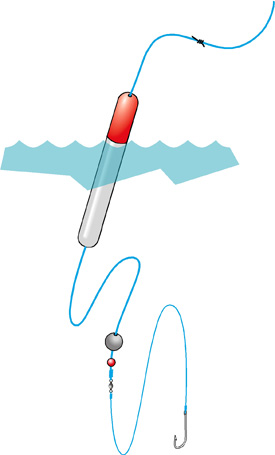 A float fishing rig is ideal for casting from piers, jetties and harbour walls.
A float fishing rig is ideal for casting from piers, jetties and harbour walls.When you don't want to present your bait on or close to the seabed, a float rig (or in the US, a 'bobber' rig) is what you need.
It's an ideal fishing rig for casting from harbour walls and piers, and a sliding float rig lets you present your bait deep without compromising the long casting abilities of this rig.
Live Bait Rigs
Using live bait is seen by some people as being unnecessarily cruel, but providing you can come to terms with rigging a livebait and committing it to a slow but certain death there's no doubt that it's a very effective way of catching predatory fish.
So live bait, dead bait
or lure? The debate continues, but the decision is yours to make. Personally, I'm not keen on it.
Lure Fishing Rigs
The effectiveness of today's soft plastic fishing lures is beyond question - but not if they're incorrectly rigged...
Rigging Plastic Squid Lures (or Muppets)
There's a simple rigging innovation that will decrease your plastic squid lure losses and catch more fish.
Rigging Plastic Shads and Jelly Worms
 Plastic shads and jellyworms are most effective when fished on a long trace in the same way as an imitation sandeel. You need a special z bend hook for this though.
Plastic shads and jellyworms are most effective when fished on a long trace in the same way as an imitation sandeel. You need a special z bend hook for this though.It's all about having the right kind of hook.
Well, not just that, you'll need to know how to rig it. Especially two highly effective variations on the basic rig, the Texas Rig and the Carolina Rig.
Rigging Leadhead Lures
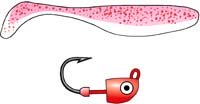 Some leadheads come complete, the head being an integral part of the lure. Others are supplied as a separate jighead and a replaceable tail, which you must combine correctly.
Some leadheads come complete, the head being an integral part of the lure. Others are supplied as a separate jighead and a replaceable tail, which you must combine correctly.Leadhead Lures have separate heads and replaceable plastic tails. These must be assembled with care to make sure that the hook emerges on the centre-line and in the right place.
A Simple Offshore Trolling Rig
 Trolling is the favourite technique of sport fishermen seeking marlin or other large ocean gamefish.
Trolling is the favourite technique of sport fishermen seeking marlin or other large ocean gamefish.Think of offshore trolling and you picture a high-powered gamefishing boat, festooned with outriggers and sporting electrically operated downriggers on their stern. It doesn't have to be like that...
Rigging Trolling Lures
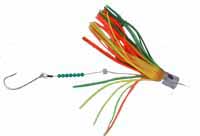 Skirted lures are probably the most popular and productive of all trolling lures.
Skirted lures are probably the most popular and productive of all trolling lures.Unlike trolling plugs and spoons, skirted lures are made up of three individual components - a skirt, a hook and a lure head. So they need to be rigged.
Baitfish Rigs (for Offshore Trolling)
First you've got to get your baitfish. You can buy it of course, but nothing beats fresh-caught bait - and this is where sabiki bait rigs excel...
Read more about sabiki bait rigs...
Rigging a Sprat or Sardine
 Any fish of the herring family makes a great trolling bait - providing it's rigged correctly.
Any fish of the herring family makes a great trolling bait - providing it's rigged correctly.Sardines, mackerel, sprats, herrings - they all make great offshore trolling baits and this bait rigging method suits them all.
Read more about bait rigging sardines, mackerel, sprats, herrings and similar baitfish...
Rigging a Flyingfish
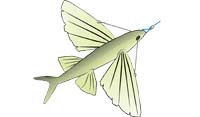 Trolled astern, a dead flyingfish rigged like this will behave very much like the real thing - sometimes submerged, at other times skipping along the surface and even taking short flights.
Trolled astern, a dead flyingfish rigged like this will behave very much like the real thing - sometimes submerged, at other times skipping along the surface and even taking short flights.Just like rigging a sardine, except for one final tweak.
Of course you cut remove its 'wings' - they're only over-developed pectoral fins afterall. But why not take advantage of them, with devastating effect?
Rigging a Ballyhoo
 Going about ballyhoo rigging the right way is vital, or your hook-up rate will be dismal. Their beak, and elongated shape, calls for a special rigging method.
Going about ballyhoo rigging the right way is vital, or your hook-up rate will be dismal. Their beak, and elongated shape, calls for a special rigging method.Ballyhoo, or halfbeaks as they're also known, are the offshore trolling baitfish rig of choice for most big game sportfishermen.
Its unusual shape and the presence of a beak (or more correctly, the bottom half of one) requires a special bait rigging technique.
Rigging a Squid
 This is the best way of rigging squid. Exuding a strong, oily-scented slick and with its tentacles fluttering astern of the hook, it will often catch when nothing else will.
This is the best way of rigging squid. Exuding a strong, oily-scented slick and with its tentacles fluttering astern of the hook, it will often catch when nothing else will.Exuding a strong, oily-scented slick and with its tentacles fluttering enticingly behind the hook, a properly rigged squid will often catch when nothing else will.
and finally...
Properly rigging your bait or your lure is essential if it's to fool the fish into thinking that grabbing hold of it is the natural thing to do.
Just follow the above links to see these proven fishing rigs explained in words and pictures.
Recent Articles
-
Sea Fishing Rods and Reels Must Be Compatible for a Balanced Outfit
Mar 08, 21 08:30 AM
A quality reel fitted to a quality rod doesn't necessarily make it a quality outfit. Your fishing rods and reels have to be properly matched if you're to get the best out of them, and here’s how -
Essential Lure Fishing Tips That All Saltwater Anglers Should Know
Mar 08, 21 04:51 AM
Which single lure fishing tip applies to trolling, jigging, baitcasting, spinning, fly fishing and any other branch of lure fishing? Well, it is the one at the top of this list -
Vital Jig Fishing Tips That You Really Cannot Afford To Miss!
Mar 07, 21 10:20 AM
Essential jig fishing tips to help you select the right lure for successful jig fishing, together with the techniques required to get the most out of your jig fishing outfit
















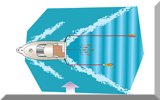

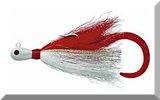
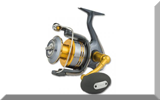
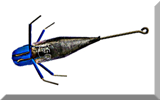
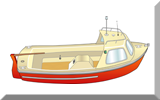
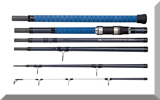
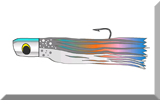
New! Comments
Have your say about what you've just read! Leave me a comment in the box below.